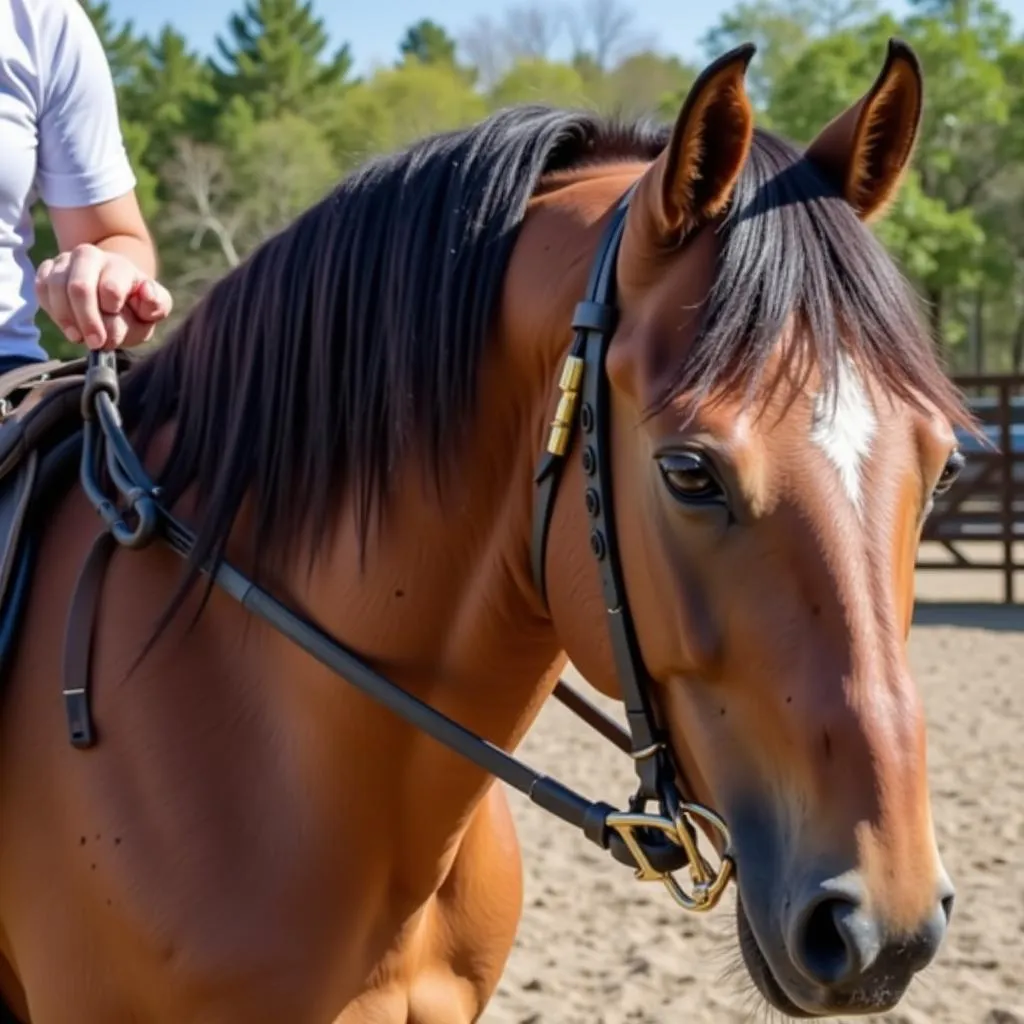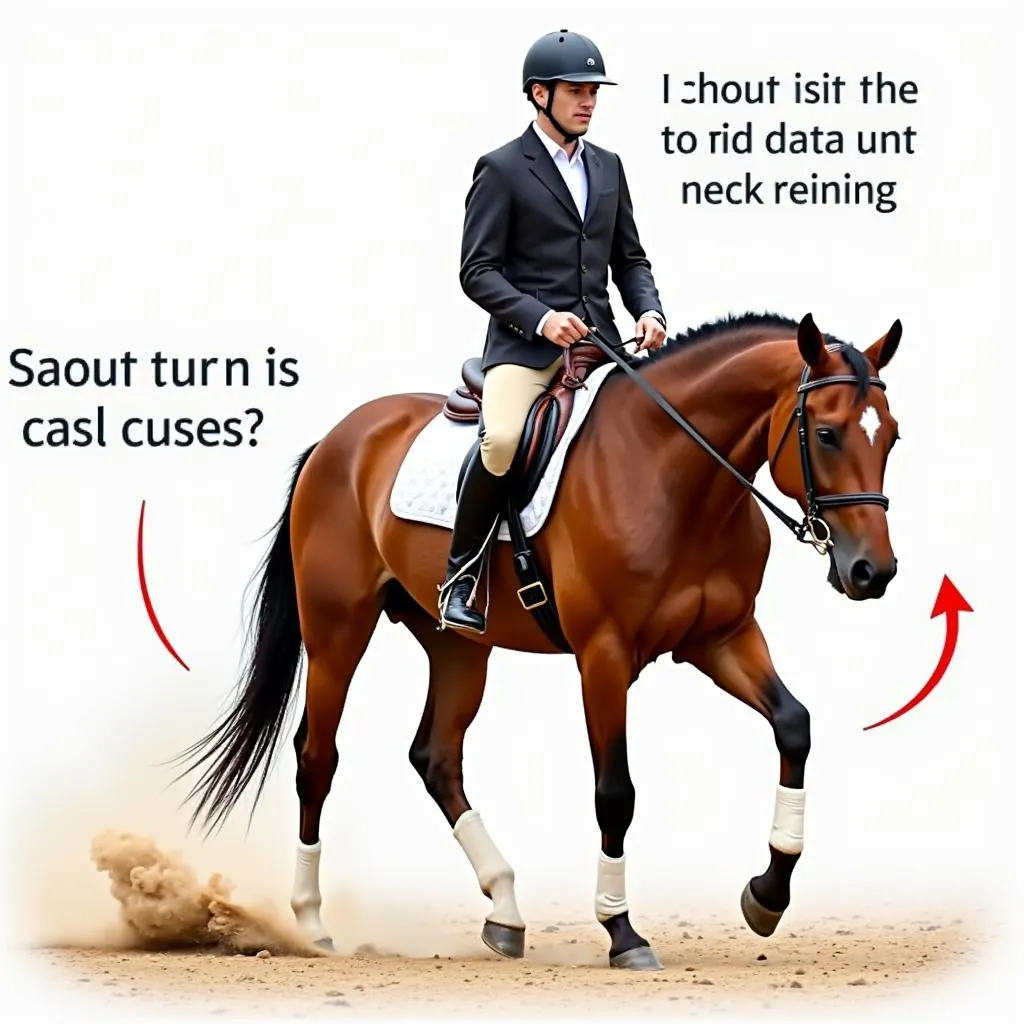Neck reining is a highly desirable skill in horses, allowing for subtle communication and effortless control. This technique, primarily used in western riding disciplines, involves guiding your horse using light pressure from the reins against the horse’s neck. Achieving this level of responsiveness takes time, patience, and consistent training. This comprehensive guide will equip you with the knowledge and techniques to successfully teach your horse to neck rein.
Understanding the Basics of Neck Reining
Before diving into the training process, it’s crucial to understand the fundamental principles of neck reining. Unlike direct reining, where pressure on both reins dictates direction, neck reining relies on a combination of leg and rein aids:
- Neck Pressure: Moving the rein against your horse’s neck acts as a directional cue. For instance, laying the left rein against the left side of the neck signals a right turn.
- Leg Pressure: Your legs provide reinforcement and clarify the direction. Applying gentle pressure with your left leg while neck reining right encourages the horse to move away from the pressure.
- Weight Shifts: Subtle shifts in your body weight also play a role. Leaning slightly in the direction you want to go helps guide your horse.
 Close Up of Horse Head and Reins During Neck Reining
Close Up of Horse Head and Reins During Neck Reining
Prerequisites for Neck Reining Success
Teaching a horse to neck rein isn’t a quick fix; it builds upon a foundation of basic training. Ensure your horse:
- Responds well to direct reining: Your horse should confidently move forward, halt, and turn using direct rein pressure.
- Yields to leg pressure: Your horse should willingly move away from leg pressure, both laterally and forward.
- Is comfortable with a snaffle or curb bit: The type of bit influences communication. Snaffle bits are milder, while curb bits offer more leverage. Choose a bit appropriate for your horse’s training level and sensitivity.
Step-by-Step Guide to Neck Reining
1. Start with Direct Reining Transitions
Begin by riding your horse in a safe, enclosed area. Practice transitions between walking and halting, using direct reining. Once your horse consistently responds, gradually introduce neck reining cues while simultaneously applying direct rein pressure.
2. Introduce Neck Reining Cues Gradually
While walking, slowly and gently lay the left rein against the horse’s neck to cue a right turn. Maintain light contact, avoiding harsh pulls. Support the cue with your right leg, applying pressure behind the girth to encourage the horse to move away from it.
3. Combine with Leg Pressure and Weight Shifts
As your horse begins to understand the neck rein cue, refine the response by incorporating consistent leg pressure and subtle weight shifts. This combined approach provides clear and unified guidance.
4. Practice, Patience, and Consistency
Like any new skill, mastering neck reining demands dedication. Practice consistently in short sessions to avoid overwhelming your horse. Celebrate small victories and remain patient throughout the process.
 Horse and Rider Performing a Turn Using Neck Reining
Horse and Rider Performing a Turn Using Neck Reining
Common Neck Reining Challenges and Solutions
- Horse ignores neck rein cues: This often stems from inconsistent or incorrect application of aids. Ensure you’re providing clear signals with your reins, legs, and body weight.
- Horse overreacts to neck pressure: This indicates the horse might be overly sensitive. Try using a lighter touch or switching to a milder bit.
- Horse leans inward during turns: This suggests the horse is not yielding to leg pressure. Focus on reinforcing leg cues to improve lateral movement.
Neck Reining: A Journey of Partnership
Teaching your horse to neck rein is a rewarding experience that strengthens the bond between horse and rider. Remember, patience, consistency, and clear communication are key to success.
“When you master the art of neck reining,” says renowned horse trainer, John Miller, “you unlock a deeper level of partnership with your horse, built on trust and responsiveness.”
FAQs
1. How long does it take to teach a horse to neck rein?
The timeframe varies greatly depending on the horse’s age, temperament, and prior training. Some horses grasp the concept quickly, while others require more time.
2. Can any horse learn to neck rein?
Most horses, with proper training and patience, can learn to neck rein. However, physical limitations might hinder certain horses from achieving optimal results.
Need Help? Contact Us!
For personalized guidance and support in your neck reining journey, don’t hesitate to reach out. Contact our team of experts at Justus Horses USA. Call us at 0772127271, email us at [email protected] or visit our location at QGM2+WX2, Vị Trung, Vị Thuỷ, Hậu Giang, Vietnam. We’re available 24/7 to assist you!